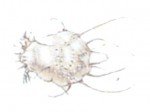
Small mites that burrow into the outermost layer of skin – the stratum corneum – are collectively called itch mites. There are many kinds of itch mites, but luckily for us, they each stick to one animal species. The species that are most important to us is called Sarcoptes scabiei. The word scabies is Latin and means rash or itching.
Physiological types. Humans have their own itch mite, Sarcoptes scabiei typicus. Other varieties of the same species infest other mammals. They look so much like the human itch that they are considered different physiological types of the same species. Examples of such a physiological difference can be that the cow’s itch mite is active in temperatures down to about 8 °C. The human itch mite cannot endure temperatures below 16 °C. In practice, it is not possible to distinguish between Sarcoptes scabiei from different host animals. The different types of Sarcoptes scabiei transmit between different kinds of host animals, but they can only breed on host animals of the same kind as the one they came from.
Scabies is characterized by intense itching and rash where the mites live. You cannot feel the mites digging in the skin. The disease scabies is the host’s reaction to the mites in the skin. Controlling the itch mites is carried out by applying a pesticide that kills both mites and eggs.
The following section deals with the itch mites in humans.




